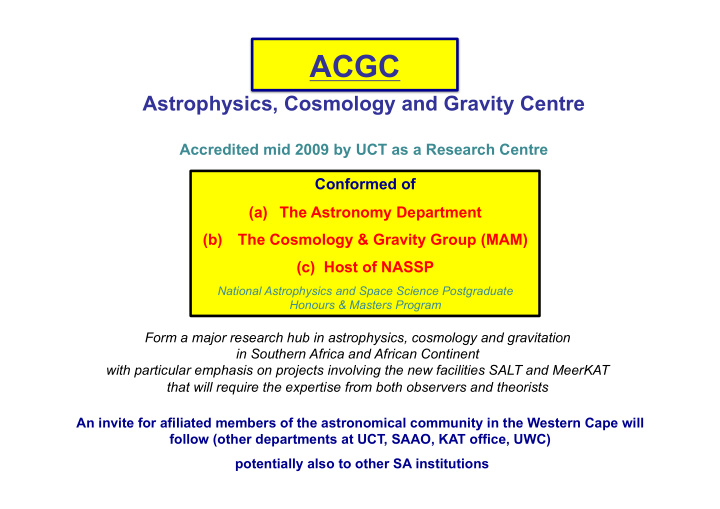



ACGC Astrophysics, Cosmology and Gravity Centre Accredited mid 2009 by UCT as a Research Centre Conformed of (a) The Astronomy Department (b) The Cosmology & Gravity Group (MAM) (c) Host of NASSP National Astrophysics and Space Science Postgraduate Honours & Masters Program Form a major research hub in astrophysics, cosmology and gravitation in Southern Africa and African Continent with particular emphasis on projects involving the new facilities SALT and MeerKAT that will require the expertise from both observers and theorists An invite for afiliated members of the astronomical community in the Western Cape will follow (other departments at UCT, SAAO, KAT office, UWC) potentially also to other SA institutions
Astrophysics in the Western Cape UWC: University of the Western Cape NiTheP: National Institute for Theoretical Physics CHPC: Centre for High Performance Computing
Core Members of the ACGC (UCT) (18 acad. staff; 11 (+4) postdocs; 36 postgrad students) Academic staff (10): Academic staff (8): • Renée C. Kraan-Korteweg • Peter Dunsby • Erwin de Blok (SARChI Chair) • Chris Clarkson • Patrick A. Woudt • Charles Hellaby • Thebe Medupe (joint SAAO/UCT) • Jeff Murugan • Kurt van der Heyden • Bob Osano • Sarah L. Blyth (SA SKA funded) • Deon Solomons • Patricia Whitelock (joint SAAO/UCT) • Amanda Weltman • Brian Warner (Emeritus Dist. Prof) • George Ellis (Emeritus Dist. Prof) • Michael Feast (Honorary Professor) • Ian Stewart (Hon. Research Ass.) Postdoctoral Fellows (8 + 2new in 2010) Affiliated Honorary Professors: • Phil A Charles (Director SAAO) Krzysztof Bolejko, Naureen Goheer, Rituparno Goswami, Alex Hamilton, Postdoctoral fellows (3 + 2new in 2010): Julien Larena, Marco Regis, Petja Salmi, Benne Holwerda, Se-Heon Oh, Matthew Mat Smith Schurch Postgraduate students: Postgraduate students: 14 (7 PhD + 7 MSc) students in 2010 22 (8 PhD, 14 MSc) students (2010)
ACGC Retreat in Montfleur (24-26 March 2010) Goal: enable clear communication between researchers within ACGC, explore areas of common interest and assess the changing astronomical landscape in South Africa and the position of ACGC within this future landscape
Further Growth: Allocation of SKA Research Chair (hosted at Astronomy Department/ACGC) : Extragalactic Multi-wavelength Astronomy with emphasis on galaxy formation, evolution and cosmology through radio observations with MeerKAT and synergies with ground and/or space-based observations in the optical, infra-red and mm-domain For 3 cycles of 5 years each, i.e. 15 years total. 3 million ZAR/year (~430’000 AUD) for salary, equipment, travel money, competitive postgraduate & postdoc bursaries, some admin support Advertisement of joint UCT/SAAO staff position (Lecturer/Sen Lecturer) strengthen collaboration between UCT and SAAO (in accordance with UCT/SAAO MoU) First official ACGC PDRA to join Centre shortly (Dr. Garry Angus) more PDRA possibilities (SKA, UCT, Leon foundation, NRF scarce skills) personal application: CONTACT POTENTIAL COLLABORATOR/SUPERVISOR to jointly prepare application
Support not only from Science Faculty but UCT Research Office and UCT in general VC Strategic Funding (250’000 Rand/year) - Centre administrator (50%); - PDRA top-ups; - support for ACGC visitors First ACGC space allocation - 175 m 2 on top floor of Botany inbetween AST and COS building; - with potentially a further 600-700 m 2 to be freed in next two years - 1’200 000 Rand for renovation from Science Faculty Goals: - new dedicated space for NASSP: NASSP computer lab; NASSP admin help, visiting lecturers from partner institutions; allowing for potential growth of NASSP - ACGC common space: common seminar/meeting room; coffee and social room; space for visitors and/or postdoc overflow
Website (in the making): With new logo http://www.acgc.uct.ac.za - Weekly Journal club - Weekly ACGC seminars - Social events
Research areas of the ACGC • observational cosmology • galaxy evolution and transformation • extragalactic large-scale structures, • dark energy & Chamaleon DE distance scale and cosmic flow fields • modified gravity • neutral hydrogen (HI) and dark matter content of nearby galaxies • inhomogeneous cosmology • Galactic structure • string theory and cosmology • high-speed stellar photometry and • early universe physics spectroscopy of variable stars (CV’s) • modelling inhomogeneity • stellar pulsations • history of astronomy • gravitational wave physics
Recommend
More recommend